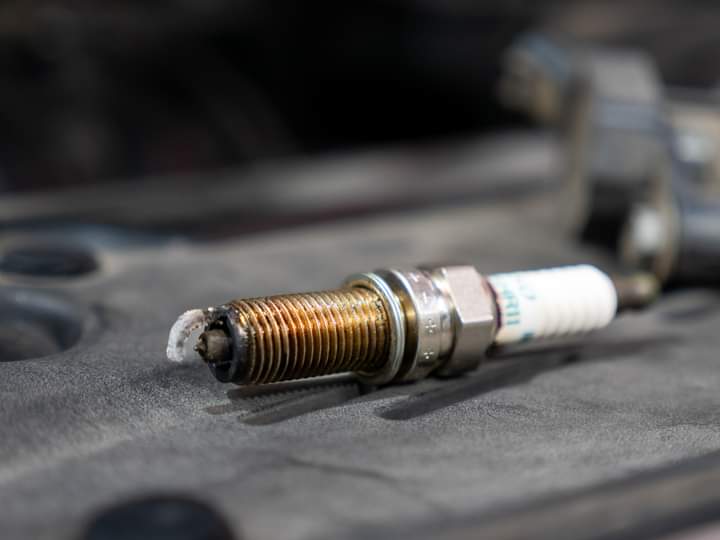As an Amazon Associate, we earn from qualifying purchases. This does not affect the price you pay or the quality of the products you buy. For more information, please read the full affiliate disclosure here.
If your engine is hard to start, runs rough, or consumes more gas than usual, you might have a fuel fouled spark plug.
This means that your spark plug, which is responsible for igniting the air-fuel mixture in the engine, is coated with fuel or other substances that prevent it from sparking properly. This can reduce the engine’s power, efficiency, and lifespan.
So, in this blog post, you will learn the symptoms of fuel fouled spark plugs, what causes fuel fouling, how to diagnose and fix it, and how to avoid it in the future.
Symptoms of Fuel Fouled Spark Plugs
Some of the symptoms of a fouled spark plug are:
1: Contaminated spark plug: A fouled spark plug will have a wet, black, or oily appearance. It may also smell like gasoline or have carbon deposits on the electrode.
2: Difficulty starting the engine: A fouled spark plug will make it harder to start the engine, as it will not produce a strong and consistent spark. The engine may take longer to crank or fail to start at all.
3: Misfiring engine: A fouled spark plug will cause the engine to misfire, meaning that the air-fuel mixture will not combust properly in the combustion chamber. This will result in a rough idle, poor acceleration, and reduced power.
4: Poor fuel economy: A fouled spark plug will affect the engine’s efficiency and performance, leading to increased fuel consumption and emissions.
5: Strange exhaust smell: A fouled spark plug will create incomplete combustion and leave unburned fuel in the exhaust system. This will cause the exhaust to smell like fuel or have a black or blue color.
What Causes Fuel Fouled Spark Plugs in Generators?

Fuel fouling spark plugs, especially in generators, occur when the spark plug electrode becomes wet with fuel or other substances that inhibit the formation of a strong and consistent spark. This can happen due to several factors, such as:
1. Rich air-fuel ratio
This means that the mass of fuel is higher than the mass of air in the combustion chamber. This can be caused by a defective fuel injector, a restricted air intake system, a faulty oxygen sensor, or a leaking fuel pressure regulator. A rich mixture can also result from using the wrong type of fuel for the generator, such as gasoline with a high ethanol content. Ethanol has a lower energy density than gasoline and can increase the fuel consumption and emissions of the generator. A rich mixture can lead to incomplete combustion and fuel accumulation on the spark plug electrode.
2. A cold engine
When the engine is cold, it needs more fuel to start and run smoothly. However, if the engine is not warmed up properly, some of the excess fuel can remain on the spark plug electrode and cause fouling. This can happen if the generator is not used frequently or is stored in a cold environment. To prevent this, it is recommended to run the generator for at least 15 minutes every month and store it in a dry and warm place. This will help the engine reach its optimal operating temperature and burn fuel more efficiently.
3. Short-Period Running
If the generator is frequently used for short periods of time, the engine may not reach its optimal operating temperature. This can also result in incomplete combustion and fuel accumulation on the spark plug electrode. To prevent this, it is advised to run the generator for at least 30 minutes every time it is used. This will help the engine burn off any excess fuel and carbon deposits on the spark plug electrode.
4. Oil leakage
If the piston rings or valve seals are worn or damaged, oil can leak into the combustion chamber and mix with the fuel. This can create a thick and sticky substance that coats the spark plug electrode and reduces its effectiveness. This problem is more common in older or poorly maintained generators. To prevent this, it is important to check the oil level and quality regularly and replace the oil and filter as needed. This will help prevent oil contamination and maintain the engine’s lubrication and compression.
5. Contaminated fuel
If the fuel contains water, dirt, or other impurities, it can affect the quality of the combustion and leave deposits on the spark plug electrode. This can happen if the fuel is stored for a long time, exposed to moisture, or mixed with different grades of fuel. To prevent this, it is essential to use fresh and clean fuel that meets the specifications of the generator and store it in a sealed and dry container. This will help prevent fuel degradation and corrosion of the fuel system components.
RECOMMENDED READ:- Why Is Your Generator Sputtering? (And How to Fix It)
How do I diagnose fuel fouling in a generator?
To diagnose fuel fouling, you need to inspect the spark plug and check its condition. You can do this by following these steps:
Step 1: Remove the spark plug.
First, you need to locate the spark plug and remove it from the engine. You may need to use a spark plug wrench or socket to do this. Make sure the engine is cool and the generator is turned off before you do this. Also, be careful not to damage the spark plug wire or boot when you disconnect it from the spark plug.
Step 2: Examine the spark plug.
Next, you need to examine the spark plug and look for signs of fuel fouling. A fuel fouled spark plug will have a wet, black, or oily appearance. It may also smell like gasoline or have carbon deposits on the electrode. You can compare the spark plug with a new one or use a spark plug color chart to determine the condition of the spark plug.
Step 3: Test the spark plug.
Finally, you need to test the spark plug and see if it can produce a spark. You can do this by reconnecting the spark plug wire to the spark plug and holding the spark plug near a metal part of the engine. Then, you can crank the engine and observe the spark. A good spark plug will produce a bright blue spark. A fuel-filled spark plug will produce weak or no spark at all. You can also use a spark tester tool to measure the spark intensity and gap of the spark plug.
How do I fix fuel fouling in a generator?
To fix fuel fouling, you need to replace the spark plug and address the underlying cause of the problem. You can do this by following these steps:
Step 1: Replace the spark plug.
First, you need to replace the fuel-filled spark plug with a new one that matches the specifications of the generator. You can find the spark plug type and gap in the owner’s manual or on the generator’s label. You may need to use a spark plug gapping tool to adjust the gap of the new spark plug. Then, you can install the new spark plug in the engine and reconnect the spark plug wire. Make sure the spark plug is tightened properly and the wire is secured firmly.
Step 2: Fix the air-fuel ratio
Next, you need to fix the air-fuel ratio and ensure that the engine is getting the right amount of air and fuel for combustion. You can do this by checking and cleaning the fuel injector, the air filter, the oxygen sensor, and the fuel pressure regulator. You can also use a fuel additive or stabilizer to improve the quality and performance of the fuel. If you are not sure how to do this, you can consult a professional mechanic or technician.
Step 4: Warm up the engine.
Finally, you need to warm up the engine and let it run for a while to burn off any remaining fuel or deposits on the spark plug. You can do this by running the generator for at least 30 minutes under a moderate load. This will help the engine reach its optimal operating temperature and spark plug condition. You can also use a spark plug cleaner tool or spray to remove any stubborn deposits on the spark plug.
RECOMMENDED READ:- Generator Backfiring Through Carburetor: Causes and Solutions
How do you prevent fuel fouling?
To prevent fuel fouling, you need to maintain the generator and the spark plug regularly and use the right type and quality of fuel. You can do this by following these tips:
1. Check and replace the spark plug.
You should check the condition and gap of the spark plug at least once a year or every 100 hours of operation, whichever comes first. You should replace the spark plug if it is worn, damaged, or fouled. You can find the recommended spark plug type and replacement interval in the owner’s manual or on the generator’s label.
2. Use the correct fuel.
You should use fresh and clean fuel that meets the specifications of the generator. You should avoid using gasoline with a high ethanol content, as it can cause fuel degradation and corrosion. You should also avoid mixing different grades of fuel or using old or contaminated fuel. You can find the recommended fuel type and storage guidelines in the owner’s manual or on the generator’s label.
3. Clean the fuel system.
You should clean the fuel system and remove any dirt, water, or debris that may have accumulated in the fuel tank, filter, or injector. You should also use a fuel additive or stabilizer to improve the quality and performance of the fuel. You can find the recommended fuel system cleaning and maintenance procedures in the owner’s manual or on the generator’s label.
4. Adjust the air-fuel ratio.
You should adjust the air-to-fuel ratio and ensure that the engine is getting the right amount of air and fuel for combustion. You can do this by checking and cleaning the air filter, the oxygen sensor, and the fuel pressure regulator. You can also use a diagnostic tool or a multimeter to measure the air-fuel ratio and make the necessary adjustments. You can find the recommended air-fuel ratio and adjustment methods in the owner’s manual or on the generator’s label.
5. Run the generator regularly.
You should run the generator regularly and let it reach its optimal operating temperature and spark plug condition. You should run the generator for at least 15 minutes every month and for at least 30 minutes every time it is used. This will help the engine burn off any excess fuel or carbon deposits on the spark plug and prevent fuel fouling. You can also use a load bank or a resistive load to simulate the power demand and test the generator’s performance. You can find the recommended load and testing guidelines in the owner’s manual or on the generator’s label.
Final Thought
In this blog post, we have learned about fuel fouled spark plugs, a common problem that can affect the performance, efficiency, and lifespan of your generator. We have discussed the causes, symptoms, diagnosis, and solutions of fuel fouling and provided some tips on how to prevent it in the future. By following these steps, you can ensure that your spark plug is in good condition and your generator is running smoothly and reliably. We hope you found this blog post helpful and informative. If you have any questions or comments, please feel free to leave them below.
Share


